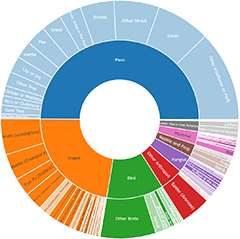Other non-black fungi
As the heading suggests, this subgroup holds a mixed-bag of on-wood leftovers. A few examples of what you find in this subgroup are:
Some polypores. Mostly these would be the flat or sheet-like polypores (technically resupinate polypores), commonly found on the lower surfaces of dead or live wood. There are also a few species that produce pendant fruitbodies (and most likely to be seen in the Canberra Nature Map area are the rusty-brown Coltriciella fruitbodies on the underside of rotting wood).
Corticioid fungi. Mostly these occur on the underside of dead wood lying on the ground, though a few are found on live wood. Mostly the fruitbody is fairly thin (often like a coat of paint or a skin on the wood) and many have featureless surfaces, so it is understandable to see them sometimes called paint fungi. However, the surface may be rough (e.g. warted, toothed, densely wrinkled), though the roughness is usually under a millimetre in depth. Furthermore, fruitbodies range from a thin and almost invisible wash to densely cobwebby to leathery in texture.
Septobasidium. The fruitbodies in this genus are brown, velvety patches that appear on branches of live plants. Though the fruitbodies appear on wood, the fungi parasitize scale insects and under a velvety Septobasidium patch you will find scale insects.
Announcements
There are currently no announcements.
Discussion
zzz puzzles on wood
zz flat polypore - white(ish)
Some polypore species have very small pores, up to 10 per millimetre. To see such pores you may need to use a magnifying glass or hand lens. A close-up shot with a macro lens would also do the job – but even without that, if you enlarge a photo you my see the pores, depending on the quality of the photo. Here (https://www.neotropicalfungi.com/wp-content/uploads/2024/04/ANGE1885-Rigidoporus-microporus_risultato.jpg) is a photo of Rigidoporus microporus. In a description of this species you’d read that there are 6-9 pores per millimetre. One specimen has been turned to show the orange-brown underside and there are no obvious pores. If I enlarge this photo I still don’t see any pores but soon get into a pixelated image. Perhaps the original photo would show the pores – or perhaps the camera was not close enough to allow pores to show in any magnification of the original photo.
Sometimes a tiny-pored underside may show a slightly fuzzy look, since a smooth surface reflects light differently to a surface with numerous tiny pores. Your photo of the underside is a little blurry. If the edges had been sharp and the rest of the undersurface had been slightly fuzzy (but not obviously out of focus) I’d have suspected a pored surface.
zz flat polypore - white(ish)
zz flat polypore - white(ish)
zz flat polypore - white(ish)
Top contributors
- trevorpreston 69
- Hejor1 29
- Heino1 18
- KenT 15
- CanberraFungiGroup 14
- TimL 12
- Heino 10
- Paul4K 8
- Teresa 6
- Caric 5
Top moderators
- Heino1 122
- Heinol 22
- Heino 16
- Teresa 6
- MichaelMulvaney 4
- CanberraFungiGroup 3
- Csteele4 2
- KenT 1
- Pam 1
- LyndalT 0












